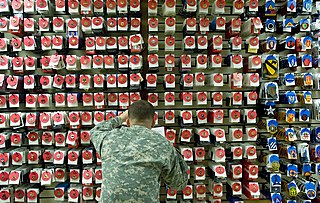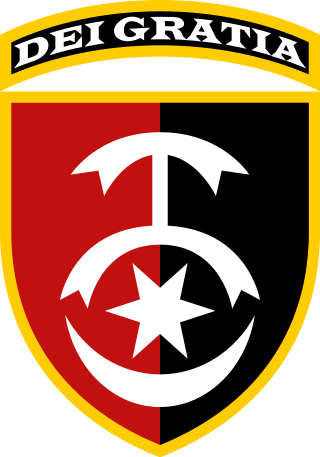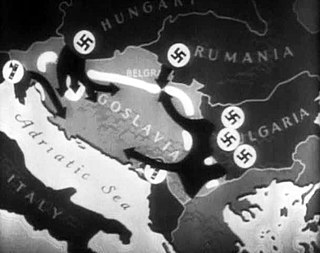Related Research Articles

The 1st Cavalry Division is a combined arms division and is one of the most decorated combat divisions of the United States Army. It is based at Fort Cavazos, Texas. It was formed in 1921 and served during World War II, the Korean War, the Vietnam War, the Persian Gulf War, with the Stabilization Force in Bosnia-Herzegovina, in the Iraq War, in the War in Afghanistan as well as Operation Freedom's Sentinel and Operation Inherent Resolve. As of October 2017, the 1st Cavalry Division is subordinate to III Armored Corps and is commanded by Major General John B. Richardson.

The 9th Infantry Division is an inactive infantry division of the United States Army. It was created as the 9th Division during World War I, but never deployed overseas. In later years, it would become an important unit of the U.S. Army during World War II and the Vietnam War. It was also activated as a peacetime readiness unit from 1947 to 1962 at Fort Dix, New Jersey, and Fort Carson, Colorado, and from 1972 to 1991 as an active-duty infantry division at Fort Lewis, Washington. Nicknamed the "Old Reliables", the division was eventually deactivated in December 1991.

A distinctive unit insignia (DUI) is a metallic heraldic badge or device worn by soldiers in the United States Army. The DUI design is derived from the coat of arms authorized for a unit. DUIs may also be called "distinctive insignia" (DI) or, imprecisely, a "crest" or a "unit crest" by soldiers or collectors. The U.S. Army Institute of Heraldry is responsible for the design, development and authorization of all DUIs.

The 10th Armoured Division was an armoured formation of division-size of the British Army, raised during the Second World War and was active from 1941–1944 and after the war from 1956–1957. It was formed from the 1st Cavalry Division, a 1st Line Yeomanry unit of the Territorial Army (TA) which had previously been serving in Palestine. The division was converted from cavalry to armour and redesignated from 1 August 1941.

The Philippine Army (PA) is the main, oldest and largest branch of the Armed Forces of the Philippines (AFP), responsible for ground warfare and as of 2021 had an estimated strength of 101,000 soldiers backed by 100,000 ready reserves. The service branch was established on December 21, 1935, as the Philippine Commonwealth Army. The Philippine Army has engaged in many conflicts including the ongoing Communist rebellion in the Philippines, the Moro conflict and, alongside other national military forces, in conflicts of international scope.

The IV Army Corps "Thrace" is an army corps of the Hellenic Army. Established before the First World War, it served in all conflicts Greece participated in until the German invasion of Greece in 1941. Re-established in 1976, it has been guarding the Greco-Turkish land border along the Evros River, and is the most powerful formation in the Hellenic Army.
This is the Operation Herrick ground order of battle, which lists any British ground forces that have taken part in the duration of Operation Herrick between 2002 and 2014.

The 30th Prince Konstanty Ostrogski Mechanized Brigade is a formation of the Ukrainian Ground Forces. The full name of the unit is 30th Independent Mechanized Brigade "Konstanty Ostrogski".

The Yugoslav order of battle before the invasion of Yugoslavia includes a listing of all operational formations of the Royal Yugoslav Army, Royal Yugoslav Army Air Force and Royal Yugoslav Navy immediately prior to the World War II invasion of that country in April 1941.

The Axis order of battle for the invasion of Yugoslavia was made up of the various operational formations of the German Wehrmacht and Waffen-SS, Italian Armed Forces and Hungarian Armed Forces that participated in the invasion of Yugoslavia during World War II, commencing on 6 April 1941. It involved the German 2nd Army, with elements of the 12th Army and a panzer group combined with overwhelming Luftwaffe support. The eighteen German divisions included five panzer divisions, two motorised infantry divisions and two mountain divisions. The German force also included two well-equipped independent motorised regiments and was supported by over 800 aircraft. The Italian 2nd Army and 9th Army committed a total of 22 divisions, and the Royal Italian Air Force had over 650 aircraft available to support the invasion. The Hungarian 3rd Army also participated, with support from the Royal Hungarian Air Force.
The 3rd Army was a Royal Yugoslav Army formation commanded by Armijski đeneral Ilija Brašić during the German-led Axis invasion of the Kingdom of Yugoslavia in April 1941 during World War II. It consisted of two reinforced infantry divisions, two infantry divisions, and a brigade-strength horsed cavalry detachment. It formed part of the 3rd Army Group, and was responsible for the Yugoslav-Albania border between Lake Ohrid and Lake Skadar.
The 1st Motorised Brigade was a formation of the Royal Hungarian Army that participated in the Axis invasion of Yugoslavia during World War II.
The 2nd Motorised Brigade was a formation of the Royal Hungarian Army that participated in the Axis invasion of Yugoslavia during World War II.
The 2nd Cavalry Brigade was a formation of the Royal Hungarian Army that participated in the Axis invasion of Yugoslavia during World War II.
The 1st Infantry Brigade was a formation of the Royal Hungarian Army that participated in the Axis invasion of Yugoslavia during World War II.
The Northern Cyclist Battalion was a bicycle infantry battalion of the Territorial Force, part of the British Army. Formed in 1908, it served in the United Kingdom throughout the First World War and in 1920 it was converted as part of the Royal Garrison Artillery.

The 1st Cavalry Division of the Royal Yugoslav Army was established in 1921, soon after the creation of the Kingdom of Serbs, Croats and Slovenes, which became the Kingdom of Yugoslavia in 1929. In peacetime it consisted of two cavalry brigade headquarters commanding a total of four regiments. It was part of the Yugoslav 1st Army Group during the German-led World War II Axis invasion of Yugoslavia in April 1941, with a wartime organisation specifying one cavalry brigade headquarters commanding two or three regiments, and divisional-level combat and support units.

The 15th Military Division also known as the 15th Military Region was an infantry formation of division-size of the Armistice Army that was active during World War II. The division's headquarters was in Marseille. This division was subordinated to the 1st Group of Military Divisions.
References
- Niehorster, Leo (2013). "Balkan Operations Orders of Battle 5th April 1941". Archived from the original on 24 April 2014. Retrieved 24 April 2014.